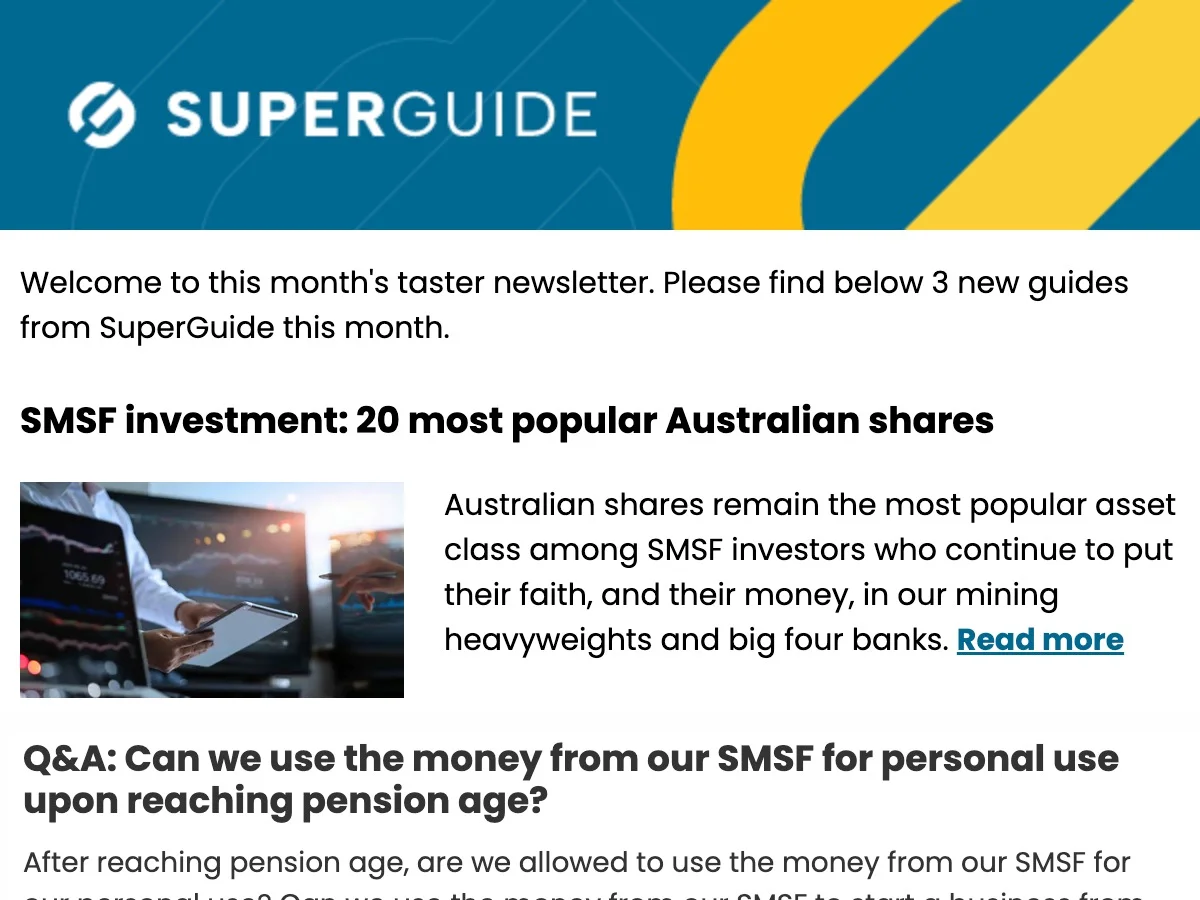In this guide
Size matters when it comes to the investment performance of self-managed super funds (SMSFs), but not as much as we’ve been led to believe.
The latest research shows investment returns of SMSFs with a balance of $200,000 or more are comparable to returns from much larger funds regulated by the Australian Prudential Regulation Authority (APRA), with several provisos.
To compete with the big end of town, SMSFs must be well diversified and not hold too much cash. SMSFs that use an adviser also have an edge over their non-advised peers.
That said, SMSFs tend to outperform APRA funds in depressed markets and underperform in good years. More on this later.
A report titled Self-managed Super Fund Performance 2022–23 (the Report) conducted by the University of Adelaide for the SMSF Association analysed returns from over 421,000 SMSFs in the 2023 financial year. This represents almost 70% of the entire SMSF population.
2026 SMSF calendar
Our free calendar includes due dates for important documents plus suggested dates for trustee meetings and other strategic issues for your SMSF.
"*" indicates required fields
The Report builds on earlier work by the same researchers on SMSF performance over the period 2017–22. Their ongoing findings have been instrumental in debunking the once-common assumption that SMSFs with less than $500,000 in assets generally underperform APRA-regulated funds.
These were the key findings.
SMSFs underperform in the short term
As mentioned above, SMSFs tend to underperform large APRA funds when markets are buoyant. This is even more pronounced when global shares outpace the domestic market, as they did in the 2023 financial year.
While large funds typically invest a significant proportion of their assets in global markets, SMSFs are heavily weighted to Australian shares. In fact, the Report previously found that only 2% of all SMSFs hold international shares.
In 2022–23, Australian shares returned a healthy 9.7% but the US market, for example, did even better with a return of 17.7%. This is reflected in the table below, which shows a median ROR for SMSFs of 6.6%, trailing the median APRA return of 8.4%.
| 25th percentile | Median ROR | 75th percentile | |
|---|---|---|---|
| SMSFs | 1.6% | 6.6% | 11.6% |
| APRA funds | 8.0% | 8.4% | 9.3% |
Source: Self-managed Super Fund Performance 2022–23

Free eBook
SMSF investing essentials
Learn the essential facts about the SMSF investment rules, how to create an investment strategy (including templates) and how to give your strategy a healthcheck.
"*" indicates required fields
What is striking from this table is that the top 25% of SMSFs outperform APRA funds by 11.6% to 9.3%. Conversely, the bottom 25% of SMSFs significantly underperform, 1.6% to 8.0% for APRA funds. The Report suggests one reason for APRA funds’ narrower range of returns could be a tendency toward ‘benchmark hugging’.
But other factors also play a role in the performance of SMSFs.
Size matters, up to a point
Around 11% of the SMSFs in the study had less than $200,000 in assets, which dragged down the overall performance of the sector. Small funds tend to have a higher allocation to cash and less ability to optimally diversify their investments. Previous iterations of this Report found high levels of cash and too little or too much diversification reduced returns.
As you can see in the table below, larger SMSFs with assets of $200,000 or more had a median ROR of 7.0%, closing the gap with APRA funds’ median return of 8.4% and significantly outperforming small SMSFs with a median return of just 0.4%.
| 25 percentile | Median ROR | 75th percentile | |
|---|---|---|---|
| All SMSFs | 1.6% | 6.6% | 11.6% |
| Large SMSFs | 2.4% | 7.0% | 11.7% |
| Small SMSFs | -4.7% | 0.4% | 9.7% |
| Advised SMSFs | 4.5% | 7.6% | 10.7% |
| Non-advised SMSFs | 1.4% | 6.4% | 11.7% |
Source: Self-managed Super Fund Performance 2022–23
This adds further weight to earlier research by Rice Warner that found SMSFs with balances of $200,000 or more were cost-effective compared with industry and retail super funds.
Supercharge your SMSF

"*" indicates required fields
The Report also looked at the effect on performance, if any, of getting advice. It did this by identifying approximately 13.4% of SMSFs in its sample that reported expenses related to advice.
As you can see in the table above, the median ROR of advised SMSFs (7.6%) was significantly higher than the median return of non-advised SMSFs (6.4%) and is edging closer to the median APRA fund return of 8.4%.
However, the top 25% of non-advised SMSFs returned 11.7%, outpacing the top 25% of both their advised peers (10.7%) and APRA funds (9.3%). Go figure.
SMSFs meet and beat large funds over five years
One-year returns are interesting, but we all know that superannuation is a long-term investment.
As the University of Adelaide has been conducting its research on SMSF performance since 2016–17, it now has annualised rates of return for rolling five-year periods to June 2021, 2022 and 2023. For this comparison, the researchers used mean (average) returns, not median returns, and removed outlier funds at the top and bottom of the SMSF and APRA samples.
As you can see in the table below, SMFSs outperformed APRA funds on an annualised basis over each of these five-year periods by between 0.3% and 1.3%.
| Five-year annualised RORs | June 2021 | June 2022 | June 2023 |
|---|---|---|---|
| SMSF sector | 8.3% | 6.5% | 6.5% |
| APRA fund sector | 8.0% | 5.2% | 5.3% |
Source: Self-managed Super Fund Performance 2022–23
The bottom line
The latest research shows that SMSF trustees can be confident that their fund can be competitive with APRA funds once it has assets of at least $200,000, especially over the long term. The evidence also suggests returns may be enhanced by diversifying beyond the Australian sharemarket and by seeking professional advice.



Leave a Reply
You must be logged in to post a comment.